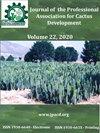Postharvest effects of 1-MCP and Chitosan/Oleic acid coating in Pitaya (Stenocereus griseus H.)
IF 0.4
4区 农林科学
Q4 HORTICULTURE
Journal of the Professional Association for Cactus Development
Pub Date : 2021-03-09
DOI:10.56890/jpacd.v23i.322
引用次数: 5
Abstract
Pitaya (Stenocereus griseus H.) is an exotic fruit produced in some regions of Mexico, where it is mainly consumed fresh and valued in local markets. Its pulp has an intense red color, sweet flavor, small and easily chewable seeds, and compounds with antioxidant capacity, such as betalains and phenolics, which confer the fruit an important nutraceutical value. Therefore, in selected markets, the price of pitaya is considered high. However, pitaya has big spines that cause consumer rejection, due to the possibility of puncture. The spines also make it difficult to handle pitaya and cause mechanical damages. These circumstances make it indispensable to remove the spines from the fruit, but collaterally, the shelf-life is decreased, and consequently, its commercialization in distant markets is more difficult. It has been reported that postharvest treatments, such as application of 1-methylcyclopropene (1-MCP) and chitosan (Ch) coatings added with hydrophobic components like oleic acid (OA), aid in preserving the quality of several horticultural products, but this effect has not been studied in pitaya. In the present study, the effects of 1-MCP (4.2 µL L-1) and/or a coating prepared with 9.1 g L-1 of Ch + 6.4 mL L-1 of OA (CO) were evaluated over the quality of pitayas, which were previously despined (D) during refrigeration (11 ± 1 °C; 93 ± 2 % relative humidity (RH)) for 15 d. The quality parameters studied were respiration pattern, ethylene production, weight loss, titratable acidity, skin firmness, and total soluble solids (TSS). It was found that the respiration rate and ethylene production corresponded to the climacteric type, independently of the treatment. The refrigeration conditions, minimized notoriously the weight loss of the fruits of practically all treatments. CO alone maintained the quality parameters and delayed the appearance of fungi, extending the shelf-life of despined pitayas up to 15 d. However, 1-MCP alone was not capable of preserving the evaluated quality parameters. The best treatment was D+CO+1-MCP, since it reduced notoriously the respiration and ethylene production rates, and inhibited loss of skin firmness, TSS, and acidity of the fruit. The results obtained herein are a progress in the limited knowledge of the postharvest physiology of pitaya fruit. More research is needed to deepen this knowledge and to optimize the postharvest handling of pitaya, in order to develop its market at global level for the benefit of producers and consumers.1-MCP和壳聚糖/油酸包衣对火龙果采后的影响
火龙果(Stenocereus griseus H.)是一种产于墨西哥一些地区的外来水果,在那里它主要是新鲜的,在当地市场上很有价值。它的果肉呈深红色,味道甜美,种子小而易咀嚼,含有抗氧化能力的化合物,如甜菜素和酚类物质,这使其具有重要的营养价值。因此,在选定的市场,火龙果的价格被认为是高的。然而,火龙果有很大的刺,由于可能刺破,会引起消费者的排斥。这些刺也使火龙果难以处理,并造成机械损伤。这些情况使得必须从水果中去除刺,但附带的是,保质期缩短,因此,其在遥远市场的商业化更加困难。据报道,采后处理,如应用1-甲基环丙烯(1-MCP)和壳聚糖(Ch)涂层,添加疏水成分如油酸(OA),有助于保持几种园艺产品的质量,但这种效果尚未在火龙果中研究。在本研究中,我们评估了1- mcp(4.2µL L-1)和/或9.1 g L-1 Ch + 6.4 mL L-1 OA (CO)制备的涂层对火龙果质量的影响,火龙果在冷藏(11±1°C)期间被抑制(D);93±2%相对湿度(RH), 15 d。研究的质量参数为呼吸模式、乙烯产量、失重、可滴定酸度、皮肤紧致度和总可溶性固形物(TSS)。结果发现,呼吸速率和乙烯产量与更年期类型相对应,与处理无关。冷藏条件,使几乎所有处理的水果减重降到最低。单独添加CO可以保持质量参数,延缓真菌的出现,将木龙果的保质期延长至15 d。然而,单独添加1-MCP不能保留评价的质量参数。最好的处理是D+CO+1-MCP,因为它明显降低了呼吸和乙烯的产生速度,并抑制了果皮紧致度、TSS和酸度的下降。本文所获得的结果是对火龙果采后生理的有限知识的一个进步。需要更多的研究来加深这方面的知识,并优化火龙果的采后处理,以便在全球范围内开发火龙果市场,造福生产者和消费者。
本文章由计算机程序翻译,如有差异,请以英文原文为准。
求助全文
约1分钟内获得全文
求助全文
来源期刊

Journal of the Professional Association for Cactus Development
Agricultural and Biological Sciences-Plant Science
CiteScore
1.10
自引率
33.30%
发文量
10
期刊介绍:
The editors of the Journal of the Professional Association for Cactus Development, are very excited to be a part of the excellent editorial committee and to work together to create the synergism between scientists, growers, legislators, and business people so vital to the development of this industry to serve the people of arid lands.
 求助内容:
求助内容: 应助结果提醒方式:
应助结果提醒方式:


